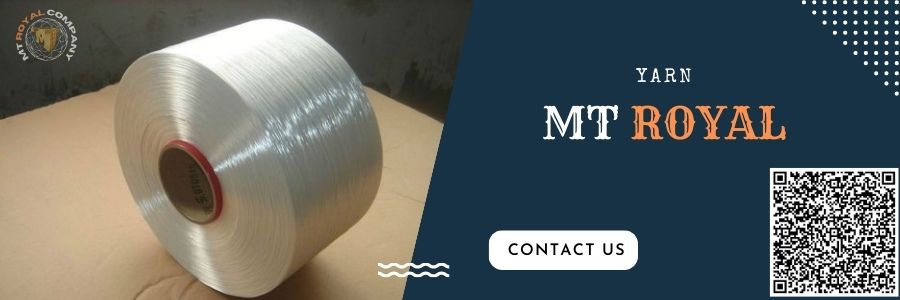What is Yarn ?
Yarn is a long, thin and continuous structure formed by the combination of discontinuous or continuous textile fibers by twisting or other methods.
Yarn is a collection of fibers that have been drawn, brought to the desired dimensions, optionally twisted and folded, and processed ready for use. Threads are infinitely long structures created by combining fibers. Yarn types are divided into three groups according to their raw materials (cotton, wool, linen, nylon, etc.), structure (fancy, folded, crepe, etc.) and according to their place of use (sewing thread, knitting thread, etc.).
Fabric production or use in sewing, etc. Yarns are a thin and long textile product that is formed by combining various fibers and fiber bundles to form a certain mass and strengthening the connection between them by twisting.
Fibers make up fibers (fiber is the smallest unit in raw material and textile) and fibers (formed by the combination of fibers) make up yarns.
Yarn is the state of being twisted and drawn from each of the long thin fibers of fabric raw materials (cotton, linen, wool, silk, nylon, etc.) and is formed by making it suitable for textile, sewing, crochet, knitting, weaving, embroidery and rope production. . Thread is a type of fiber made suitable for hand or machine sewing. Modern production sewing threads are finished with wax or other lubricants (to resist pressure at the time of sewing). Embroidery threads are threads specially designed for hand or machine embroidery.

Spun yarn is the adhesion of fibers by twisting or bringing them together to make a strong permanent, durable yarn. The process of twisting the fibers within the yarn is called spinning and can be dated to about 40,000-10,000 years ago from what is now known as the late stone age. The spinning process is one of the first signs of industrialization. The spun yarn may contain a single type of fiber as well as various types of blends. A combination of man-made fiber (having a high strength, artificial luster, and fire resistance quality) and natural (natural) fibers (having a good water absorption and leather-feeling capacity) is very common. The most used blends are cotton-polyester and wool-acrylic fibers.
Mixtures of different natural fibers are also common, especially angora and cashmere. Yarns are made of several layers; each layer is a single twisted yarn. These single twist plies are twisted together in opposite directions to produce a thicker yarn. Based on the direction of the final twist, the yarn will be known as s-twist or z-twist.
For more information about Yarn and raw materials, MT ROYAL CO able to advise you in this field. Also, MT ROYAL CO are one of the companies who produce and supply all types of spandex yarn, ITY, Cationic pet chips, pet chips for textile grade. If you expect the best type of yarn with the reasonable price, please contact us.
Yarn Twist
In all spinning systems, twist is given to the yarn by turning it around its axis. Twisting depends on the type of fiber from which the yarn is made, the type of yarn (weft, warp yarn, etc.) and the properties of the fabric to be made from it. Soft twist is a small number of twists, it is used for knitting. Twisting two or more layers is applied to the single-ply yarns formed after the spinning process. The purpose here is It is to keep the yarn layers together by giving the yarn durability and usability.
Twist; twisting direction of the yarns and 1m. It is related to the number of twists per person. Twisting Types and Structures Twisting types occur in two ways according to the twisting direction of the yarn. While twisting the yarn,” Z” twist is obtained when it is turned clockwise, and “S” twist is obtained when it is rotated counterclockwise. In general, sewing threads are offered for sale as multi-ply thread. There are also compound twisted yarns, fancy twisted yarns and coated twisted yarns.
The layers of the yarn, which are given insufficient twist, are separated one by one and break quickly. Negatives such as clumping and tangling can be seen in the yarn that is given too much twist. 1m. The yarn is divided into four according to the number of twists per head. slight twist: The number of twists in 1m is 200. Soft, water absorbent yarns are produced. Normal twist: The number of twists in 1m is 200-600. Stronger yarns are produced. Excessive twist: The number of twists in 1m is 600-1200. Hard and granular yarns are produced. excessive twist: The number of twists in 1m is 1300-2500. Multi-grained yarns are produced that shrink when wet.
What is Acrylic Thread?
As the name of acrylic yarn suggests, its raw material is acrylic.
So, what exactly is acrylic?
Acrylic: It is a synthetic material that can be turned into yarn, fabric, or many other products. Acrylic is basically a type of plastic.
Let’s touch on a few points about what is an acrylic thread: First, acrylic thread is not found naturally. It is man-made. For example, wool and cotton are found naturally, while acrylic is classified as a synthetic product. The scientific definition of the word acrylic is a long chain synthetic polymer. If we leave the scientific definition aside, in short, acrylic is a type of plastic.
Acrylic contains 85 percent of a clear, poisonous, water-soluble chemical substance called acrylonitrile. According to the report of the Environmental Protection Agency in the USA, this substance is among the carcinogenic substances that cause cancer. Of course, this does not mean that every acrylic thread user will get cancer. However, it is healthier to use cotton or wool yarn instead of acrylic yarn.
MT ROYAL Co. is the manufacturer and supplier of all types of yarns for example, FDY, DTY, ITY, SPANDEX YARN. For more information and get offer please contact us.

